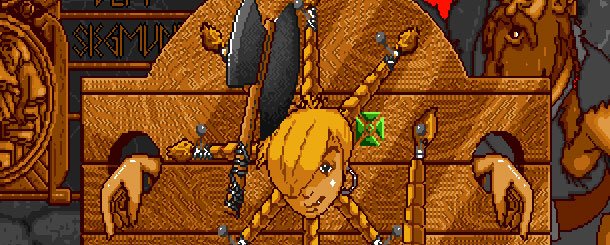From 2010 to 2014 Richard Cobbett wrote Crapshoot, a column about rolling the dice to bring random obscure games back into the light. This week, if you want to know what to play, press Play!
Back at the start of the 90s, the PC was still at war with the Amiga and the Atari ST, nobody yet felt like roadkill on the information super-highway, mullets were finally an endangered species, and adding the word 'cyber' to a word made it the most proto-radical thing since, like, something totally triumphant. But on the plus side, Gremlins 2 was brilliant and some other things were okay.
Click isn't simply a nostalgic glance back at those days. It's a video time capsule that lasted just two issues, I suspect due to the difficulty of persuading stores to fill their shelves with VHS tapes, and its then-staggering cost of £5. Let's crack it open and take a peek at its secret juice.

Commercial failure or not, I remember being sad that there was never a third issue of Click. Rewatching both episodes now, it still seems like a shame. This was long before YouTube and CD-ROM made video ubiquitous—the only real way to see games in motion without buying them was to hold a magazine up to your eyes and jiggle it around a bit. Simply getting to see something like Elite or Double Dragon 3 in action was cool, with each of Click's reviews offering a good couple of minutes of sexily cut-together footage to enjoy. And not (always) just from the intro/first levels!
For the most part, it also avoids the most common pitfall—trying to be too cool for school. Nobody raps, there are no EXTREME CLOSE-UPS, and while the action is set in a fictionalised version of the magazine's office, there are no outright characters like the Gamesmaster/Games Mistress, Nam Rood or Dave Perry, and no big storyline except the team trying to finish the issue. Instead, everyone plays a tongue-in-cheek version of themselves, with (hopefully made-up) complete disdain for everyone else around them, with the second issue especially playing things up. Editor Tony is officially cursed to be left out of anything cool, second reviewer Robert's deeply uncomfortable performance in front of the camera ends up morphing into increasingly anal management, and (in a less than PC move) the cast take most of the issue to realise that their sole female colleague, Lucy, has changed between episodes and is now a completely different woman called Rachel. And then respond to her frustrated cry that the office needs more women with cheers and a cry of "Get a blonde!" Who says gaming is a boys' club, eh?
(On the plus side, this does bring an end to the toe-curling running gag of John 'the office brat' constantly trying to pick her up in ways even Wesley Crusher would wince at. Why do these things always feel they need a kid-identification figure? Have any of them ever been popular? The answer is no.)

Click's first feature remains one of my favourites, though not for the same reason as when I first saw it. Two words: Virtual Reality. To recap: In the early 90s, when 3D graphics were still a novelty, any arcade wanting to make a squillion pounds would install one of these machines—usually a sit-down flight game called VTOL, though others were available. You'd pay a pound or two to wear a spectacularly heavy helmet with a couple of monitors and movement sensors in it, reeling at the incredible experience of being able to look around and interact with a blurry virtual world in more or less real-time. The problems were obvious—motion sickness, headaches, and the fact that the games themselves were rubbish—but the experience is one I highly recommend if you ever find yourself in the 90s with a case of amnesia and a bit of loose change to spare. Also, you'll probably want to buy shares in Apple while you're there. Just a thought.
Oh, and don't get a Cyber Razor Cut. Game Genie works much better.
Being of this time itself, Click unsurprisingly takes the "OH MY GOD THIS IS AMAZING!" approach to the tech, and I promise at the time, it was. Similar features then go on to give the same treatment to other now hilariously quaint innovations, including a role-playing game called Shadowlands which gets a whole segment based on nothing more than a lighting engine, an earnest discussion of whether you should import a Super Famicom from Japan (conclusion: maybe, if you were rich and spoke Japanese), and my personal favourite, a review of the Core Design game Heimdall where the reviewer breathlessly narrates "If you're not sat at home now saying 'wow', I want to know why!"
Heimdall was pretty awful, with its most memorable bits being the mini-games you played to generate your character—especially the first, where you prove your Viking prowess by throwing axes at a girl's pigtails. But never mind. As disappointing as it was when I finally got to play it, I did get to enjoy a year or so of thinking it looked like the coolest RPG ever. So that was some consolation.

Even without the snark bait, Click's reviews were pretty dreadful things—very little criticism, only surface level descriptions, and more than a few face-palm moments. By far the worst has to be the review of the inevitable Captain Planet game, where the reviewer is apparently under the illusion that the show is Japanese and has a main character called "Fire", and claims it doesn't fit into any gaming genre despite it quite obviously being a platformer, before finally concluding "The game is basically unplayable" and awarding it 71%. Gasp! No! Not 71%! That's the lowest of all the numbers!
(Even here though, at least the reviewer does comment on the game, and elements like its bad controls. Far too many of the others appear to be using the ancient and celebrated art of reviewing from the back of the box, especially early on. Last Ninja 3 stands out here, "Bleeping brilliant" or not.)
For video reviews at the time though, this was still pretty solid, and nobody buying a magazine like this wasn't also going to get a platform-specific one with hopefully slightly more informative reviews. The fun wasn't seeing what you were going to buy yourself so much as getting a step closer to playing some of the ones you never would, be they action games on other platforms, like Rolling Ronnie and Mega Twins, or just things you were never going to devote weeks of pocket money to. Super Space Invaders, anyone? It's the sequel with no equal, apparently, but a few minutes of video was all the nostalgia it deserved. Thought of like that, Click's £5 price was a pretty good deal. You could even get your money back if you ordered one of the reviewed games through its mail order service, though I'm pretty sure you'd still be paying way more than if you did a little price comparison because duh.

While both issues of Click soon vanished from the shelves, it's good that copies remain. Each is around 45 minutes long, and an entertaining bit of time travel. There's an endearingly hand-made quality to them that helps bridge the gap, from a feature on covermounts self-destructing in the first issue to the constant attempts to persuade industry types to let readers/viewers send in demo discs to be filed instantly in the nearest bin, to the way that almost none of the cast seem to have any real experience in front of camera. (Though at least one, designated office joker Jake Wood, did end up having a proper TV career afterwards, appearing in Red Dwarf, Eastenders, and quite a few other shows.)
Prepare for one disappointment here though—that the PC gets very little love throughout. Many of the games covered were actually available on the One True Platform, but the versions seen are inevitably the Amiga and Atari ST ones. In fairness to the magazine, more or less, and the kinds of RPG and adventure that made it great at the time were generally going to be less exciting to watch and less conducive to info-blast type information. And in glorious victory, we can probably afford to be a little bit gracious to the long-fallen competition. Or just giggle at what people like that were reduced to playing while we all moved on to bigger and better games like Doom and Ultima VII and the popular party treat Smashing Old Amigas With Sledgehammers. Ah, such sweet, sweet victory...
Smashing Old Atari STs With Sledgehammers is also acceptable, of course.
from PCGamer latest https://ift.tt/3jqkwaw
ليست هناك تعليقات:
إرسال تعليق